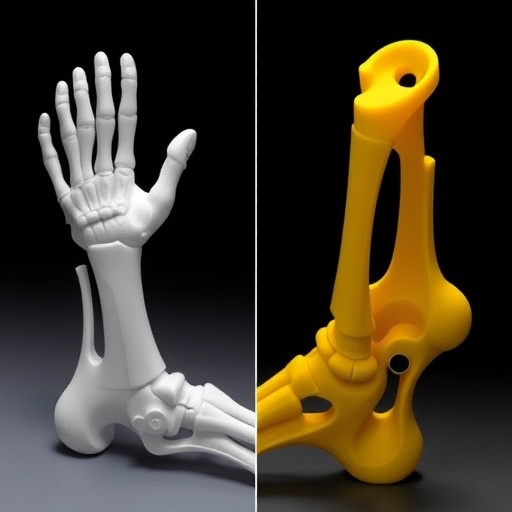3D printing technology has made remarkable strides in various fields, particularly in medicine and healthcare. A cutting-edge application of this technology is the creation of orthopedic prostheses and orthoses, which play a crucial role in enhancing the quality of life for individuals with limb deficiencies or musculoskeletal disorders. Recent research conducted by Pelczarski et al. signifies a pivotal advancement in this domain, showcasing how 3D printing can revolutionize the fabrication of prosthetic and orthotic devices.
The traditional methods of producing orthopedic devices often involve complex processes that can be time-consuming and costly. Conventional techniques typically require skilled artisans and multiple production steps to create a single prosthesis or orthosis. However, with the emergence of 3D printing, these complexities can be dramatically simplified, allowing for faster and more efficient production. This technology utilizes computer-aided design (CAD) software to create intricate models that are then built layer by layer using various materials.
A key advantage of 3D printing in orthopedic applications is the potential for customization. Each patient has unique anatomical features, which makes a one-size-fits-all approach impractical. Traditional methods often fall short of accommodating individual needs, leading to discomfort and suboptimal functionality. In contrast, 3D printing allows healthcare providers to create bespoke devices that perfectly fit an individual’s specific dimensions, enhancing both comfort and performance. This level of personalization is achieved by integrating advanced imaging techniques, such as MRI or CT scans, into the design phase.
The materials used in 3D printing for orthopedic devices are continually evolving, expanding the possibilities of what can be achieved. From biocompatible plastics to innovative metal alloys, the selection of materials allows for not just functional devices but also lightweight and durable options. This is particularly beneficial for prostheses, where weight is a critical factor in user comfort and mobility. The strength-to-weight ratio can be optimized, leading to devices that are both manageable and robust.
Another compelling aspect of 3D printing in this field is the reduction in production costs. Traditional prosthetic manufacturing involves significant labor and time investments, which can make these devices prohibitively expensive for many patients. With 3D printing, the costs associated with materials and production methods can be significantly lowered. This democratization of technology holds promise for improving access to vital orthopedic care, making high-quality prostheses and orthoses available to a broader segment of the population.
In addition to cost-effectiveness, 3D printing offers swift production times that can be crucial in clinical settings where time is of the essence. The ability to obtain a ready-to-use device within a matter of hours or days rather than weeks can dramatically impact a patient’s recovery and rehabilitation process. The quicker delivery times can enable patients to begin their rehabilitation earlier, leading to improved long-term outcomes and satisfaction.
While the benefits of 3D printing are clear, it is imperative to address the challenges associated with implementing such technology in clinical practice. Regulatory hurdles are one of the primary obstacles that must be navigated to ensure that 3D-printed devices meet safety and efficacy standards. Regulatory bodies are currently working to establish clear guidelines regarding the manufacture and use of these innovative devices, ensuring that patients receive safe and reliable products.
Moreover, as with any emergent technology, there is an ongoing need for research to understand the long-term performance and durability of 3D-printed orthopedic devices in real-world settings. The studies presented by Pelczarski et al. contribute significantly to this body of knowledge, providing insights into the efficacy of these devices as they are used in diverse clinical scenarios. Continuous assessment of patient satisfaction, device longevity, and functional outcomes is critical to gaining clinician and patient trust in 3D-printed solutions.
Additionally, training and education for healthcare professionals is essential. As 3D printing becomes more integrated into orthopedic practice, it is vital that clinicians are equipped with the knowledge and skills to leverage this technology effectively. Educational programs and workshops focusing on the design, production, and post-processing of 3D-printed devices are crucial steps toward adopting these innovations broadly.
The intersection of 3D printing and personalized medicine could redefine orthopedic care. As healthcare systems strive to deliver more individualized treatment plans, 3D printing stands out as a frontrunner in revolutionizing not just the production of prosthetic and orthotic devices, but the entire patient experience. Enhanced customization options can lead to greater patient satisfaction and improved functional outcomes, thereby fostering a more holistic approach to orthopedic care.
As the world continues to embrace 3D printing technology, the implications for orthopedic care are far-reaching. The potential for innovation is immense, as researchers, engineers, and medical professionals collaborate to solve real-world problems affecting millions of people. With ongoing advancements in material science, design software, and production techniques, the future of 3D printing in orthopedics appears incredibly promising.
In conclusion, the research by Pelczarski et al. on the applications of 3D printing in creating orthopedic prostheses and orthoses opens new avenues for exploration and implementation in medical practice. The synergy of advanced technology with traditional care models will likely result in enhanced patient outcomes, increased accessibility, and the potential to shape the future landscape of orthopedic devices. As we look ahead, the integration of 3D printing into orthopedic practice will be pivotal in continuing to advance the field and improve lives.
Subject of Research: 3D Printing in Orthopedic Prostheses and Orthoses
Article Title: 3D Printing in the Creation of Orthopedic Prostheses and Orthoses
Article References:
Pelczarski, M., Kazimierczuk, K., Mydlikowska, M. et al. 3D Printing in the Creation of Orthopedic Prostheses and Orthoses.
J. Med. Biol. Eng. (2025). https://doi.org/10.1007/s40846-025-00984-x
Image Credits: AI Generated
DOI: 10.1007/s40846-025-00984-x
Keywords: 3D printing, orthopedic prostheses, orthoses, personalization, biocompatible materials, cost reduction, regulatory challenges, patient outcomes.




